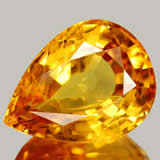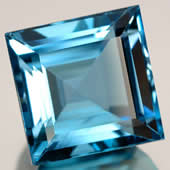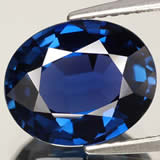The belief that gemstones have special healing powers goes back
centuries and is associated especially with the Vedic astrological
tradition in India. Practitioners from that tradition claim to offer
ways to utilize the power stored in gems to maximize physical and
psychological balance and well-being. Many people believe in the healing
powers of gemstones and offer personal accounts of how their lives have
been changed for the better by using the right gemstones.
 For example, yellow sapphire
is thought to attract wealth and bring prosperity to the home. It is
said to stimulate the intellect and improve overall focus, enhancing
wisdom. Those who find obstruction in the progress of their educational
field, or those who suffer losses from property matters should, it is
recommended, wear yellow sapphire for removal of their difficulties. Many believe that a girl who wears yellow sapphire
will get married early. It is also alleged to aid in eliminating
impurities from the body and stimulating the lymphatic system.
Astrological gemologists recommend yellow sapphire to treat liver and
gallbladder problems as well as disorders of the spleen and stomach.
For example, yellow sapphire
is thought to attract wealth and bring prosperity to the home. It is
said to stimulate the intellect and improve overall focus, enhancing
wisdom. Those who find obstruction in the progress of their educational
field, or those who suffer losses from property matters should, it is
recommended, wear yellow sapphire for removal of their difficulties. Many believe that a girl who wears yellow sapphire
will get married early. It is also alleged to aid in eliminating
impurities from the body and stimulating the lymphatic system.
Astrological gemologists recommend yellow sapphire to treat liver and
gallbladder problems as well as disorders of the spleen and stomach.
In the modern world this belief in magical powers just seems quaint
to most scientifically-minded people. No one can deny that the belief
in the healing power of gemstones has been historically important.
Perhaps the gemstone industry even encourages the idea out of
self-interest. But the skeptic would say that the idea of gaining some
therapeutic value from a gemstone mineral held close to the skin is very
doubtful, especially to the degree claimed by many practitioners of
"gemstone healing."
As far as we know, no scientific studies have examined the claims
of gemstone healing. It would seem that the scientific community does
not take the idea seriously enough to expend the effort needed to test
these claims. But is this level of skepticism justified?
 Consider the idea that a gemstone mineral held close to the skin is
extremely unlikely to have any affect on the body. This has actually
been a much discussed topic in scientific circles in recent months,
having to do with the practice of treating clear topaz with irradiation to produce blue topaz. Rumors and misinformation in the trade led some sellers to stop selling blue topaz altogether due to potential radiation danger. The American Nuclear Regulatory Commission found it necessary to issue a Fact Sheet on Irradiated Gemstones to clear up misunderstandings. They resassured the market that "The NRC has no reason to believe irradiated
gemstones currently on the market are unsafe." But this recent
controversy certainly demonstrates that gemstones worn close to the body
could have significant effects on our well-being.
Consider the idea that a gemstone mineral held close to the skin is
extremely unlikely to have any affect on the body. This has actually
been a much discussed topic in scientific circles in recent months,
having to do with the practice of treating clear topaz with irradiation to produce blue topaz. Rumors and misinformation in the trade led some sellers to stop selling blue topaz altogether due to potential radiation danger. The American Nuclear Regulatory Commission found it necessary to issue a Fact Sheet on Irradiated Gemstones to clear up misunderstandings. They resassured the market that "The NRC has no reason to believe irradiated
gemstones currently on the market are unsafe." But this recent
controversy certainly demonstrates that gemstones worn close to the body
could have significant effects on our well-being.
However, it is not only irradiated minerals that been discovered to
have special properties. Science has discovered some marvelous
properties of crystals that have led to important practical
applications. For example, the piezoelectric properties of quartz
were first discovered by Jacques and Pierre Curie in 1880.
Piezoelectricity is the ability of some materials to generate an
electric potential in response to applied mechanical stress. This
discovery eventually led to the development of quartz oscillators that were used to build highly accurate quartz
clocks. Until the adoption of atomic clocks in the 1960's, these were
the most accurate timekeeping devices in the world. With the
introduction of cheap semiconductor digital logic, quartz clocks have
become ubiquitous in consumer devices.
Another gemstone mineral with unique electrical properties is tourmaline. Tourmaline has both pyroelectric (electric potential when heated)
and piezoelectric properties. Tourmaline has been used in
pressure-sensitive gauges, beginning with submarine applications in the
Second World War. It has also been discovered that tourmaline
immersed in water has certain ion generating properties, and a number
of patents have been filed for cosmetic and cleansing applications using
tourmaline. The latest invention is the tourmaline hair dryer which is
said to dry hair more quickly with less damage.
In fact many gemstone materials have found industrial applications due to their special properties. Kyanite
has been widely used in the manufacture of spark plugs, heating
elements and high voltage electrical insulators, due to its high melting
point and low thermal expansion. Fluorite has been used in place of glass in some high performance telescopes and camera lens. Sapphire crystals doped with titanium ions are used to produce tunable lasers that can produce ultrashort pulses.
New applications for gemstone materials continue to be found.
This suggests that human understanding of the potential of these
materials is still fragmentary. Certainly there is already good reason
to think that many gemstones are rather special. But any claims for
special healing powers need to be evaluated, like any scientific claim,
by careful testing through controlled experiments.
source: www.gemselect.com




